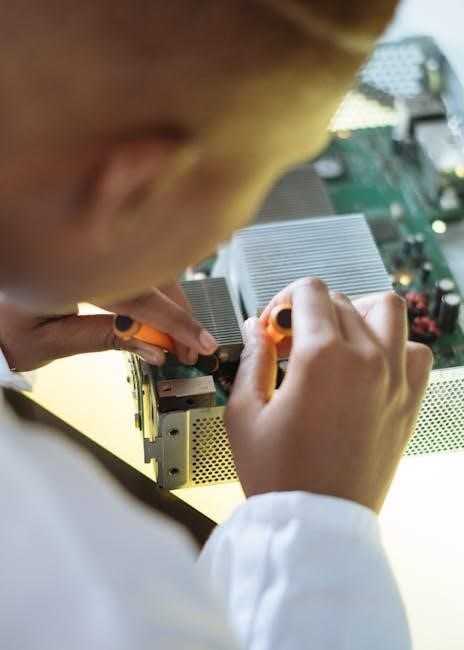
polaris sportsman 500 service manual pdf
Welcome to the Polaris Sportsman 500 Service Manual. This guide provides a comprehensive overview of your vehicle’s maintenance and service requirements. Inside, you’ll find detailed procedures to help you maintain optimal performance and ensure longevity for your Polaris Sportsman 500. The manual covers essential topics such as engine maintenance, transmission checks, suspension adjustments, and electrical system care. Whether you’re a seasoned rider or new to the Polaris Sportsman 500, this manual is your go-to resource for keeping your vehicle in top shape. Use it to perform routine tasks and address common issues effectively.
1.1 Overview of the Service Manual
The Polaris Sportsman 500 Service Manual provides comprehensive guidance for maintaining and servicing your vehicle. This manual includes detailed procedures for engine maintenance, transmission checks, and suspension adjustments. It also offers troubleshooting tips to address common issues and ensure optimal performance. Whether you’re performing routine tasks or resolving problems, the manual is your essential resource for keeping your Polaris Sportsman 500 in top condition and longevity. Always refer to it for professional servicing and maintenance advice.
1.2 Purpose and Importance of the Manual
The Polaris Sportsman 500 Service Manual is designed to ensure proper maintenance and prolong the life of your vehicle. It provides clear, step-by-step instructions for performing routine tasks, troubleshooting issues, and adhering to safety guidelines. Regularly referring to this manual ensures your machine operates efficiently and reliably. By following the guidelines, you can maintain optimal performance and prevent costly repairs. The manual is your essential tool for keeping your Polaris Sportsman 500 in top condition and ready for any adventure.

Engine Maintenance and Service
Regular engine maintenance ensures reliable performance and longevity for your Polaris Sportsman 500. Proper service includes routine inspections, cleaning, and adjustments. Following the guidelines in this section helps prevent common issues and maintains peak performance. Always adhere to safety protocols when working on the engine. Consistent care ensures optimal functionality and extends the life of your vehicle.
2.1 Overview of the Polaris Sportsman 500 Engine

The Polaris Sportsman 500 engine is a reliable and powerful 2-stroke design, offering smooth performance for rugged terrain. This advanced engine features a robust multi-cylinder configuration with overhead valve (OHV) technology, ensuring optimal power delivery and efficiency. The engine’s cooling system and air intake design enhance performance under demanding conditions. Regular inspections and adherence to maintenance schedules are essential to preserve its durability and functionality. Understanding its components and operation is key to maintaining peak performance and longevity.
2.2 Regular Oil and Filter Changes
Regular oil and filter changes are critical for maintaining the health and performance of your Polaris Sportsman 500 engine. Over time, oil degrades and accumulates contaminants that can harm engine components.25,。 manufacturer-recommended oil viscosity and type to ensure proper lubrication. ,。:
- :25
- :5W-30, 10W-3010W-40()
- :
、。, longevity.
2.3 Air Filter Maintenance
Regular inspection and maintenance of your Polaris Sportsman 500’s air filter are essential for optimal engine performance; Over time, dirt and debris can accumulate, restricting airflow and reducing efficiency. Always inspect the air filter during routine maintenance, especially after riding in dusty conditions.
To clean or replace the air filter:
- Locate the air filter housing and remove the cover.
- Inspect the filter for dirt or damage.
- Clean it with compressed air if lightly soiled, or replace it if heavily contaminated.
- Reinstall the filter and secure the cover tightly.
Replace the air filter at least every 5,000 miles or when it appears dirty, whichever comes first. Proper maintenance ensures smooth operation and protects your engine from potential harm.
2.4 Spark Plug Replacement
Spark plug replacement is crucial for maintaining optimal performance and preventing starting issues in your Polaris Sportsman 500. Over time, spark plugs can become fouled, worn, or damaged, leading to misfires and reduced engine efficiency. Check the spark plug wires and connections for signs of wear or corrosion before proceeding. To replace the spark plugs:
- Disconnect the ignition coil and carefully remove the spark plugs using a spark plug wrench.
- Clean the area around the plug holes to prevent debris from entering the engine.
- Install new spark plugs, ensuring proper gap settings according to the manual specifications.
- Tighten the plugs securely but avoid over-tightening, as this can damage the threads.
Replace spark plugs every 50,000 miles or as recommended in your service manual. Always inspect the plugs for fouling or damage to identify potential engine issues early.
2.5 Engine Timing Belt Inspection and Replacement
The engine timing belt is a critical component of your Polaris Sportsman 500, ensuring proper valve timing and engine performance. Over time, the belt can stretch, crack, or wear, leading to potential engine damage if not addressed. Regular inspection is essential to prevent costly repairs. To inspect or replace the timing belt:
- Disconnect the battery to avoid electrical hazards.
- Remove the timing belt cover and inspect the belt for signs of wear, cracks, or glazing.
- Check the belt tension; it should be firm but not overly tight.
- If wear or damage is detected, replace the belt with an approved Polaris part.
Replace the timing belt every 2 years or 30,000 miles, whichever comes first. Proper maintenance ensures smooth engine operation and prevents potential failures. Reassemble the cover carefully and reconnect the battery before testing the engine for proper functioning.

Transmission and Drivetrain
Proper maintenance of the Polaris Sportsman 500 transmission and drivetrain ensures smooth operation and longevity. Regularly inspect the transmission fluid levels, belts, pulleys, driveshaft, and clutch for wear or damage. Follow the recommended service intervals to prevent issues and maintain optimal performance; Always use genuine Polaris parts for repairs and replacements. Regular checks help ensure your vehicle remains reliable for years to come.
3.1 Understanding the Transmission System
The transmission system in your Polaris Sportsman 500 is responsible for transferring power from the engine to the wheels, enabling smooth operation. It consists of key components such as gears, belts, and pulleys. Proper understanding of its functions is essential for maintaining performance and preventing issues. Familiarize yourself with the system’s design and operation to ensure optimal functionality. Regular inspections and adherence to service intervals are critical for maintaining its efficiency and durability. Always consult the manual for specific instructions regarding checks and adjustments to avoid complications. Remember, a well-maintained transmission system guarantees a reliable and enjoyable riding experience.
3.2 Checking Transmission Fluid Levels
Regularly checking the transmission fluid levels is crucial for the smooth operation of your Polaris Sportsman 500. Insufficient fluid can lead to component wear or failure. Locate the transmission dipstick, clean it, and reinsert it fully before pulling it out to check the fluid level. Ensure the fluid is at the recommended level and of the correct type specified in the manual. If the fluid appears dirty or discolored, consider draining and replacing it. Always top up carefully to avoid overfilling. Checking fluid levels ensures optimal performance and longevity of the transmission system.
3.3 belts and Pulleys Maintenance
3.3 Belts and Pulleys Maintenance
Regular inspection and maintenance of belts and pulleys are essential for the proper functioning of your Polaris Sportsman 500. Check the belts for any signs of wear, cracks, or excessive tension. Clean the pulleys and belts with a soft cloth to remove dirt and debris. Ensure the belts are properly tensioned and replace them if necessary. Use only the manufacturer-approved tools and lubricants for adjustments. Inspecting the belts and pulleys regularly helps prevent unexpected breakdowns and ensures smooth operation of the vehicle’s systems.
3.4 Driveshaft Inspection
Inspecting the driveshaft is crucial for maintaining the integrity and functionality of your Polaris Sportsman 500. Begin by visually checking the driveshaft for signs of wear, cracks, or damage. Ensure the driveshaft is properly connected and aligned with the differential and transfer case. Look for excessive play or movement, which could indicate issues with the driveshaft or its mounting components. Regularly clean the driveshaft to remove dirt or debris that may interfere with its operation. Address any abnormalities promptly to prevent potential failures on the trail. Proper inspection ensures your driveshaft operates smoothly and safely during all terrain conditions.

3.5 Clutch Adjustment and Service
Regular clutch adjustment and service are essential for maintaining smooth shifting and optimal performance in your Polaris Sportsman 500. Begin by inspecting the clutch assembly for wear, damage, or contamination. Clean the clutch components thoroughly to remove dirt or debris that may affect operation. Check the clutch linkage and ensure it moves freely without binding. Adjust the clutch according to the manufacturer’s specifications to achieve proper engagement. Look for signs of excessive wear on clutch discs or plates, and replace them if necessary to prevent slippage or unintended gear engagement. Proper clutch maintenance ensures reliable shifting and protects the transmission system. Always follow safety guidelines when servicing the clutch to avoid injuries or damage to the vehicle.

Suspension and Controls
Proper suspension maintenance ensures a smooth and comfortable ride on your Polaris Sportsman 500. Regularly inspect and adjust components like shock absorbers to maintain optimal performance. Properly setup handlebars and foot controls enhance control and riding comfort. Inspect suspension components for wear and replace parts as needed to ensure safe and effective operation.
4.1 Suspension Components Overview
The Polaris Sportsman 500 suspension system includes key components like shock absorbers, springs, linkages, and mounts. These parts work together to absorb impact, maintain stability, and ensure optimal handling. Regular inspection and maintenance of these components are essential to preserve ride quality and safety. Properly functioning suspension enhances comfort, control, and overall performance of the vehicle.
4.2 Shock Absorber Maintenance
Proper maintenance of the shock absorbers is vital for the Polaris Sportsman 500’s suspension performance. Inspect the shocks for leaks, damage, or wear regularly. Check the mounting points for tightness and ensure all components are free from debris. Lubricate the shock absorbers as recommended in the manual to prevent wear and tear. If you notice excessive bouncing or rough handling, it may indicate worn-out shocks. Replace them immediately to maintain optimal ride quality and safety. Follow the manufacturer’s guidelines for service intervals and required tools. Regular maintenance ensures smooth operation and longevity of the suspension system.
4.3 Handlebar Setup and Adjustment
Proper handlebar setup is crucial for comfortable and safe operation of your Polaris Sportsman 500. Begin by loosening the handlebar mounting bolts to allow for adjustment. Position the bars to your preferred riding stance, ensuring they provide optimal control and reach. Tighten the bolts securely but avoid over-tightening to prevent damage. Lubricate all bolts and connections as specified in the manual. Inspect the handlebar grips for wear and replace them if necessary. Ensure the handlebars are properly aligned with the steering column and tighten all mounting bolts to manufacturer-recommended torque specs. Regularly check handlebar connections for tightness and cleanliness. Refer to the manual for specific tools and instructions to ensure proper setup and adjustment, enhancing your riding experience.
4.4 Foot Controls and Pedals
For optimal performance, ensure your Polaris Sportsman 500’s foot controls and pedals are properly adjusted and maintained. Begin by inspecting the pedals and control linkages for wear or damage. Tighten any loose connections or bolts securing the pedals. Adjust the pedal placement to suit your riding comfort, ensuring ease of use and control. Lubricate pivot points as specified in the manual to prevent unnecessary wear. Test the pedal action for smoothness and responsiveness. Conduct regular inspections to identify potential issues, such as bent pedals or fraying cables. Replace worn components promptly to maintain safe and reliable operation. Proper care of foot controls ensures precision and comfort during operation.

Troubleshooting and Common Issues
This section helps you identify and address common problems with your Polaris Sportsman 500. Start by checking for loose connections, worn-out components, or issues with the electrical system. If the engine isn’t starting, inspect the spark plugs and fuel lines. Always follow the manual’s guidance for troubleshooting and use the right tools for repairs. For persistent issues, consult a professional technician.
5.1 Common Problems and Solutions
Your Polaris Sportsman 500 may experience issues like hard starting, loss of power, or unusual noises. Hard starting often relates to ignition or fuel problems; check spark plugs and fuel lines for blockages. If the engine loses power, inspect the air filter for dirt or debris. Strange noises during operation may indicate worn belts or bearings; inspect and replace as needed. Difficulty shifting could point to transmission issues; check fluid levels and clutch adjustments. A rough ride might be due to suspension wear; inspect shock absorbers and tighten loose components. Addressing these issues promptly ensures reliable performance and prevents further damage.

5.2 Electrical System Checks

To ensure reliable operation of your Polaris Sportsman 500, regularly inspect the electrical system. Check the battery terminals for corrosion and ensure proper connections for optimal power flow. Inspect wires and connectors for damage or wear. Test the ignition system to confirm spark plug functionality. Replace worn or cracked wiring harnesses promptly. Inspect dashboard gauges and lights for proper functioning. If issues arise, consult the service manual for troubleshooting steps or seek professional assistance. Regular electrical checks enhance vehicle performance and prevent unexpected breakdowns, ensuring safe and enjoyable rides.
5.3 Ignition and Starting Issues

Addressing ignition and starting issues on your Polaris Sportsman 500 is crucial for reliable operation. Begin by checking the spark plugs; ensure they are clean and properly gapped to maintain optimal performance. Inspect ignition coil wires for wear or damage, as faulty wires can cause weak sparks and starting problems. Examine battery connections to ensure they are secure and free from corrosion, which can impede power delivery. Test the starter motor to confirm it engages the engine properly. If issues persist, consult the service manual for specific troubleshooting steps. Always seek professional assistance if you’re unsure to prevent further damage. Promptly resolving ignition and starting issues ensures the longevity and reliable operation of your Polaris Sportsman 500.
5.4 Fuel System Maintenance
Maintaining the fuel system of your Polaris Sportsman 500 is essential for optimal performance and preventing costly repairs. Begin by inspecting the fuel tank for signs of rust or contamination. Ensure the fuel filter is clean and replaced periodically to prevent debris from damaging the engine. Check fuel lines for leaks or cracks to avoid fuel loss or fire hazards. Inspect the fuel pump and fuel injectors for proper function, ensuring a steady supply of fuel to the engine. Regularly cleaning or replacing the fuel filter can prevent clogs and improve fuel efficiency. Always use high-quality fuel and avoid letting the tank run completely empty to prevent sediment buildup. If you notice fuel-related issues, such as poor performance or stalling, consult the service manual for troubleshooting steps or seek professional assistance immediately. Proper fuel system maintenance ensures reliable operation and extends the life of your Polaris Sportsman 500.
5.5 When to Contact a Professional Mechanic
It is crucial to know when to seek professional assistance to avoid potential damage or injury. If you encounter complex repairs or tasks beyond your expertise, contact a certified mechanic. Issues like brake system malfunctions, engine diagnostic problems, or electrical system failures require professional attention. Additionally, if you lack the necessary tools, knowledge, or time, do not attempt repairs independently. Trust a trained technician for tasks involving emission controls, advanced diagnostics, or safety-critical components. Remember, timely intervention can prevent minor issues from becoming major problems. Always prioritize your safety and the longevity of your Polaris Sportsman 500 by seeking professional help when needed.